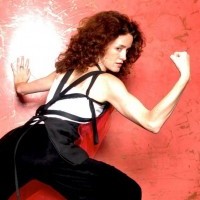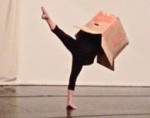
Photo: Helio Ha
Philadelphia’s Tango Moment
by Carolyn Merritt
On Thursday, May 28, 2015 tango history was made in Philadelphia: Gustavo and Giselle Anne Naveira, arguably the world’s most famous and most beloved teachers of tango, arrived to headline the 5
th Philadelphia International Tango Festival. Hosted by the Philadelphia Argentine Tango School (PATS) and organized by Executive Director, Meredith Klein, the event spanned four days and featured so much: daily classes for beginner through advanced students, nightly milongas, practice events, Gustavo and Giselle’s musicality seminar and tango history lecture, performances by all the festival teachers, a special inaugural performance by BalletX, stupendous tango djs, yoga, and more, at the Christ Church Neighborhood House and the PATS studio. I dove into the weekend full throttle—thanks to grandparents who cross state lines to babysit, much like tango dancers cross state (and country) lines to dance—taking Gustavo and Giselle’s twelve-hour seminar and dancing into the wee hours each night.
Seminar
Gustavo Naveira’s influence on tango is vast, global, and unparalleled. To say that the dance owes something of its livelihood to him is not hyperbolic. Following Argentina’s return to democracy in 1983, when tango as a social dance had nearly disappeared in its country of origin, Naveira taught a tango class in Buenos Aires that became so popular he had to turn people away at the door. In their now famed “tango investigation group” of the 1990s, Naveira and colleague Fabian Salas developed a new means of analyzing, deconstructing, and teaching tango that revolutionized the dance. Over the past 20 years with his wife and partner, Giselle Anne, Naveira has built a reputation as the consummate teacher of tango teachers. Based in Colorado with their two children, the pair have made a life of travel and teaching around the world, including yearly stints in Buenos Aires. Their seminars—advanced, partners only, designed for large groups—regularly sell out, and their presence draws dancers from across state and country lines. In the case of Philadelphia’s festival, tangueros attended from as far away as Argentina, Canada, and Europe.
Their seminar, “Rhythm, Phrasing and Musicality,” allowed participants to explore the relationship between tango dance and music by deepening our understanding of the structure of each. We began with numbers, distinguishing between the eight counts in a phrase of music and the steps that make up tango’s 8-count basic step, and agreed that numbers designate steps. From there, we moved on to double time—executing two steps within one beat—identifying the steps (or numbers) within the 8-count basic that lend themselves to double time because of their “natural” (I would say habitual) length. We covered traspie, a “trip” that happens when two steps within a single beat are executed in place, or when the foot moves out while the torso remains where it is. Highlighting the crucial nature of precision—that timing is created in context, that a couple can never execute double or any other time without first establishing the downbeat—they drilled that downbeat into us through one slowly paced exercise after another. In a nice visual model that students continued to reference throughout the weekend, Gustavo and Giselle broke a single beat of music into 4 subdivisions (or quarter beats) with 5 physical chairs (the first and last being the downbeat):
1 2 3 4 1
Gustavo demonstrated with the chairs, and then we played with emphasizing different quarter beats. Together, we listened and danced, embodying one of the more common rhythms in traditional tango music, where the quarter beats “one-two” and “four-one” are highlighted, one being the downbeat in each case:
1 2 _ 4 1 2 _ 4 1
The seminar was also a mini-education in the history and mechanics of the dance. Tango’s two walking systems—cross and parallel—differentiate it from other social dances. The introduction of the cross into the 8-count basic, and the follower’s movement from the cross to a front ocho to a turn, revolutionized the dance in the 1940s. Rather than the oldest or most “traditional” of styles, milonguero or “close embrace” is actually the last style that developed in tango’s evolution before the dance’s near demise in the 1960s.
Throughout, they shared anecdotes—of their own lives, tango history, and famed dancers no longer with us. They sparred playfully and completed one another’s gaps. Watching them together, I was reminded of tango’s contradictions. The image of machismo and of female submission, so often on the surface in stage shows and films, has little in common with the real thing (at least when it is done well). If Gustavo is the more recognized, lauded, and charismatic of the pair, Giselle more than holds her own, as a teacher, partner, and performer. Whenever necessary, she intervened—returning to a concept that hadn’t been comprehensively explained, reorienting the class to the reasoning behind technique. When my partner and I asked for feedback on a short sequence, she quietly observed once and offered, “it’s okay...” and then succinctly rattled off a laundry list of things we could work on to make it more than fine.
The seminar was a whopping time commitment (4 hours each on Friday, Saturday, and Sunday) in a weekend that invited tangueros to dance from 9:30pm-2am every night (and until 6am Sunday at the late-night milonga). When I asked Gustavo in an email conversation about the intensive nature of the seminar and the festival, he highlighted the opportunity to broaden one’s perspective on the dance by connecting with new dancers, both professional and social:
“It’s like taking a vacation from everything else in order to devote the entire weekend to tango. This has a significant effect on our dancing. Moreover, it is also a chance to meet dancers from other places that you wouldn’t otherwise, and an opportunity to become closer with various tango professionals. All this gives a much more complete picture of the tango dance and the tango scene.”
-Gustavo Naveira
In a conversation with Philadelphia dancer and sculptor Jerry Klein, he reinforced this idea of connecting with the larger tango community and tango history when he described tracing his own roots through his teacher to Naveira:
"In my mind, Gustavo Naveira stands for the tango rebirth that has grown, through the participation of countless creative individuals, into what we now have. I know that Gustavo was the fundamental teacher of my fundamental teacher, Andrés Amarilla, so you might say that, in studying with Gustavo and Giselle Anne, I am looking for reliable intergenerational roots. I hope, especially, to strengthen my feeling of personal membership in the tango family.”
-Jerry Klein
Others highlighted Naveira’s expertise as an instructor, the excitement they felt to be in the room with him:
“I was struck by what a GOOD (great) teacher Gustavo is. Not all performers are teachers but he truly is. It was much more than “this is what you do.” There was a wisdom, something else, that he conveyed through his speech, his eyes, the way he moved. We were spellbound at times, thrilled to be in his presence. Part of me didn't care if I learned anything, because I was in his class.”
-Audrey Kress, violinist
Still others remarked on the benefits of studying with new teachers, a testament to both the festival and to Meredith Klein’s tireless organizing of top-notch instructors in Philadelphia:
“When I step outside of my comfort zone and try something new, something different from the familiar, I grow.”
-Dan Dehner, senior project manager/software specialist
I took advantage of the opportunity to study more intensively with Gustavo and Giselle than I had previously, and to observe the very real impact of such intensive study. Tango is known for attracting engineers, and the seminar was heady at times. To be present, intellectually and physically, four hours a day after dancing all night is no small task. That 29 couples happily pushed through the weekend is a testament to Gustavo and Giselle. They are gifted, inspiring teachers, adept at taking the temperature of the room and adapting their instruction to the group while still attending to individuals, providing just the right measure of correction and encouragement.
History
“Lots of people dance tango without knowing it's from Argentina, many are not even interested in where it comes from, and some couldn't even tell you where Argentina is. Of course, after some time dancing, most everybody wants to know more about this—the history and the context—but that's not what keeps them in the tango community. I believe that the tango has, among other things, an amazingly high level of communication between partners while dancing, much more than any other dance. This is not only challenging, it’s irresistible. It’s very, very attractive, and that's why people continue to dance.”
-Gustavo Naveira
As I learned from experience researching tango in Buenos Aires between 2005 and 2007—including an interview with Naveira—much of tango history is unknown, forgotten, lost with the passage of the earliest generations of dancers. In our email conversation, Naveira reiterated this point when he explained the basis of the lecture he and Giselle presented on Sunday, “The Unfathomable History of Tango Dancing”:
“The lecture addresses the evolution of tango in the last century and the possible future of the dance, in light of what we know today. I cover small events in the history of the tango—in general, this information is difficult if not impossible to find, as there are few records of tango history, but several dancers shared their stories with us in their last years. Today these people are no longer with us, and with them a lot of important data is gone.”
-Gustavo Naveira
An overview of the “dancer’s experience” from tango’s origins in the late 19th century to today, the highlight is the footage they shared of some of tango’s most celebrated dancers, from some of the earliest recordings that exist. This footage, the anecdotes they shared, and explanations they provided—in words and movement—would be a rare treat for tango dancers anywhere, even in Argentina, because so much history is held in private hands. If they highlighted the personal and the anecdotal rather than the shifting socio-political context tango has moved through over time and space, this seemed appropriate given their expertise as dancers and teachers and the connections they were lucky enough to forge with their forebears. Their lecture dispelled arbitrary distinctions between the traditional and the modern in tango, the footage a testament to tango’s essential characteristics: a search for novelty and individuality, in the moment with another person. They suggested that tango’s evolution is far from over, that after a little more than a century, the dance is still just in its infancy. And while it is important to know our roots in order to move forward, they said, the future of the dance lies with the young. “Encourage the youth” were their closing words.
With all the reasons to attend this year’s festival, perhaps the most essential is the opportunity to feel part of something larger—as Naveira put it, a cultural tradition that transcends boundaries, that facilitates communion:
“Thirty years ago we were a few here and there, and we all knew each other. Today there are millions of people dancing tango, and there is tango in every city around the world. This shows how the tango can cross any cultural boundary, how accessible it is. Tango is for everyone.”
-Gustavo Naveira
By Carolyn Merritt
June 13, 2015









